The Last Convict home page
Scenes from the London prisons, 1862
Samuel Speed's Trial
Jackson's Oxford Journal 5 December, 1863
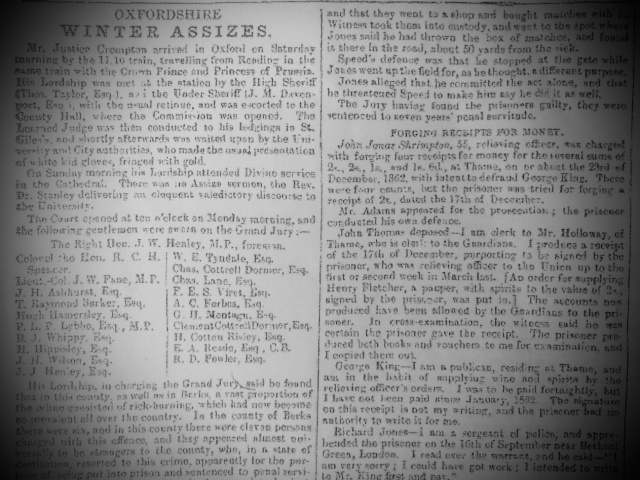
OXFORDSHIRE WINTER ASSIZES
[Extracts]
Mr Justice Crompton arrived in Oxford on Saturday morning by the 11.10 train, travelling from Reading in the same train with the Crown Prince and Princess of Prussia. His Lordship was met at the station by the High Sheriff (Thos. Taylor Esq.) and the Under-Sheriff (J. M. Devonport Esq.) with the usual retinue, and was escorted to the County Hall, where the Commission was opened. The Learned Judge was then conducted to his lodgings in St Giles’s, and shortly afterwards was waited upon by the University and City authorities, who made the usual presentation of white kid gloves, fringed with gold.
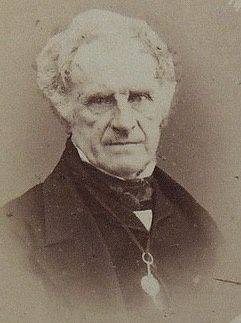 On Sunday morning his Lordship attended Divine Service in the Cathedral. There was an Assize sermon, the Rev. Dr Stanley delivering an eloquent valedictory discourse to the University.
On Sunday morning his Lordship attended Divine Service in the Cathedral. There was an Assize sermon, the Rev. Dr Stanley delivering an eloquent valedictory discourse to the University.
The Court opened at ten o’clock on Monday morning, and the following gentlemen were sworn on the grand Jury: The Right Hon. J.W. Henley, M.P. foreman [and twenty other names].
Mr Justice Crompton
His Lordship, in charging the Grand Jury, said he found that in this county, as well as in Berks, a vast proportion of the crime consisted of rick-burning, which had now become so prevalent all over the country. In the county of Berks there were six, and in this county there were eleven persons charged with this offence, and they appeared almost universally to be strangers to the county who, in a state of destitution, resorted to this crime apparently for the purpose of being put into prison and sentenced to penal servitude.
A long period of penal servitude seemed to be just what they wanted, while a short term of imprisonment would not mark the enormity of their crime. He hoped they would not find penal servitude so pleasant as they seemed to expect, and it had occurred to him in Berkshire that, if corporal punishment was to be resorted to at all, it might be in these cases, and might have some effect in deterring men from committing this crime.
The law, however, did not allow the administration of corporal punishment except to persons under 16. At Reading he ordered a boy to be flogged, and in the first case in the calendar, where a child nine years of age was charged with arson, it would evidently be no use keeping such a child in prison. It was a subject for consideration whether corporal punishment might not be extended to other persons. He thought they would find all of them quite clear cases, except one or two which he would bring under their notice.
[He then mentioned a case of forging receipts by a workhouse officer; evidence to be given in a case of rick-burning; a painful case of manslaughter where a man was defending his mother from an assault; and another case of rick-burning against two labourers where the evidence was doubtful as so many tramps were going about the county committing such cases. The other charges of arson, he thought, were very clear, the parties mostly having admitted the fact before the police and magistrates.]
*
All this to the Grand Jury before the trials even began. Then followed brief reports of the separate cases brought before the court.
*
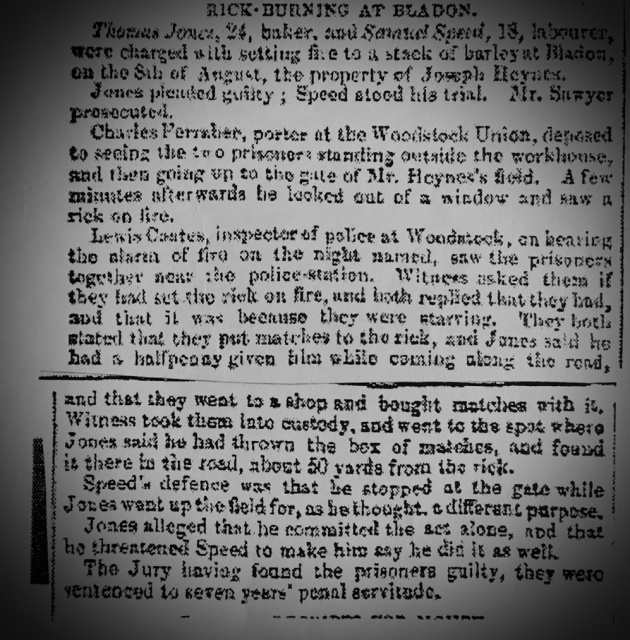
RICK-BURNING AT BLADON
Thomas Jones, 24, baker, and Samuel Speed, 18, labourer, were charged with setting fire to a stack of barley at Bladon on the 8th of August, the property of Joseph Heynes. Jones pleaded guilty; Speed stood his trial. Mr. Sawyer prosecuted.
Charles Ferrabee, porter at the Woodstock Union, deposed to seeing the two prisoners standing outside the workhouse, and then going up to the gate of Mr Heynes’s field. A few minutes afterward he looked out of a window and saw a rick on fire.
Lewis Coates, inspector of police at Woodstock, on hearing the alarm of fire on the night named, saw the prisoners standing together near the police-station. Witness asked them if they had set the rick on fire, and both replied that they had, and that it was because they were starving.
They both stated that they put matches to the rick, and Jones said he had a halfpenny given him while coming along the road, and that they went to a shop and bought matches with it. Witness took them into custody, and went to the spot where Jones said he had thrown the box of matches, and found it there on the road, about 50 yards from the rick.
Speed’s defence was that he stopped at the gate while Jones went up the field for, as he thought, a different purpose.
Jones alleged that he committed the act alone, and that he threatened Speed to make him say he did it as well.
The Jury, having found the prisoners guilty, they were sentenced to seven years’ penal servitude.
*
[Among the other arson cases]
ARSON AT ISLIP
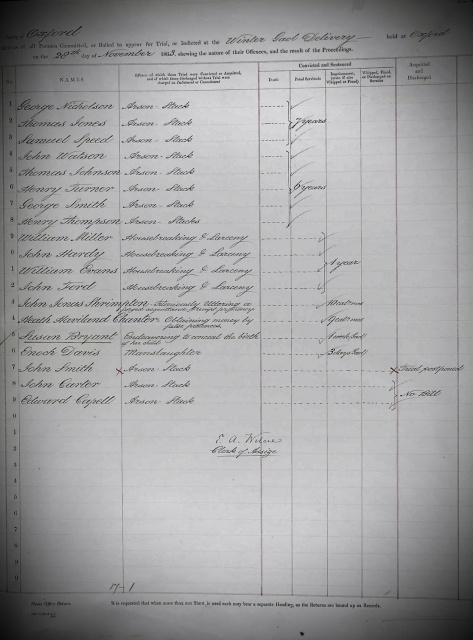 John Watson 23, labourer, Thomas Johnson, 22, cigar maker, and Henry Turner, 18, collier, pleaded guilty to setting fire to a stack of straw at Islip, the property of Geo. Alley, on the 6th of November. They stated that they had nothing to say.
John Watson 23, labourer, Thomas Johnson, 22, cigar maker, and Henry Turner, 18, collier, pleaded guilty to setting fire to a stack of straw at Islip, the property of Geo. Alley, on the 6th of November. They stated that they had nothing to say.
His Lordship observed that they had committed a very grave crime, apparently under the idea that they had better get imprisonment for a long term of years than continue going about the country. They had said they did it to get victuals, but it was a shocking thing to destroy property in this way, doing no good to themselves and infinite mischief to the people to whom it belonged.
The crime was very common, and it was necessary to treat it with great severity. They might suppose they would have a pleasant time, going into public works, but they would find a good deal they did not like before they got there, and he hoped that in a little time it would be made much more disagreeable than people in their position had any idea of. They would be sentenced to six years’ penal servitude.
Speed's Oxford Jail delivery
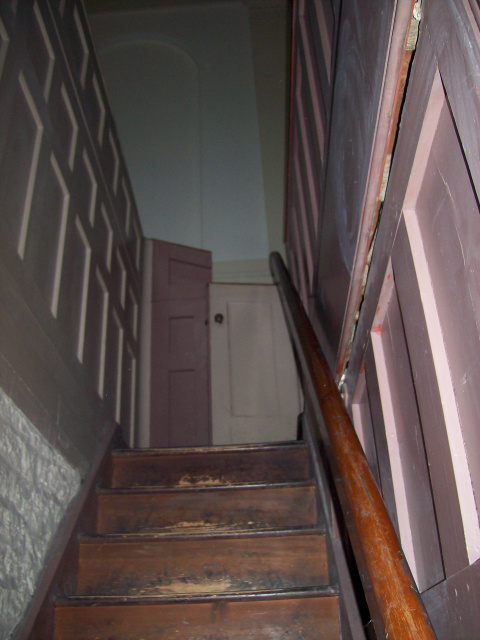
The steps Samuel Speed would have mounted to the dock, Oxford Assizes Court.
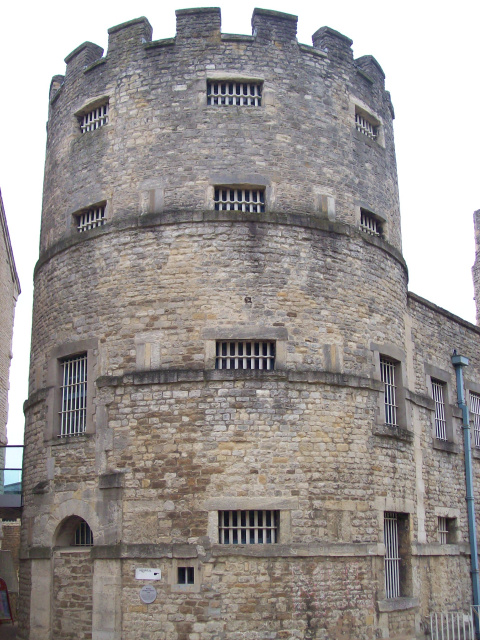
Oxford Castle prison (part)
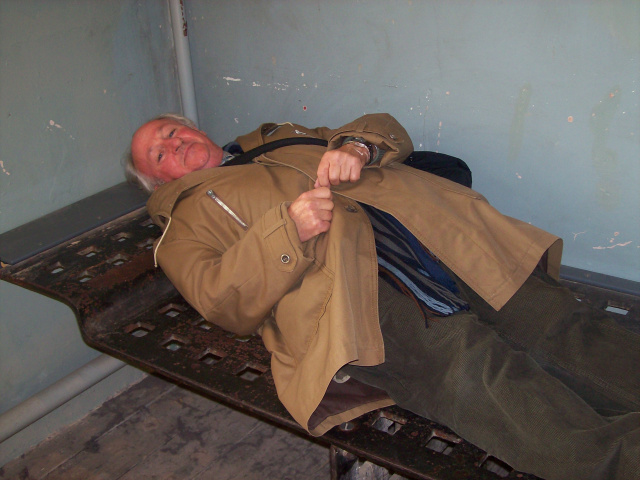
Research: The author lying on an iron bed at Oxford Castle prison (2012)